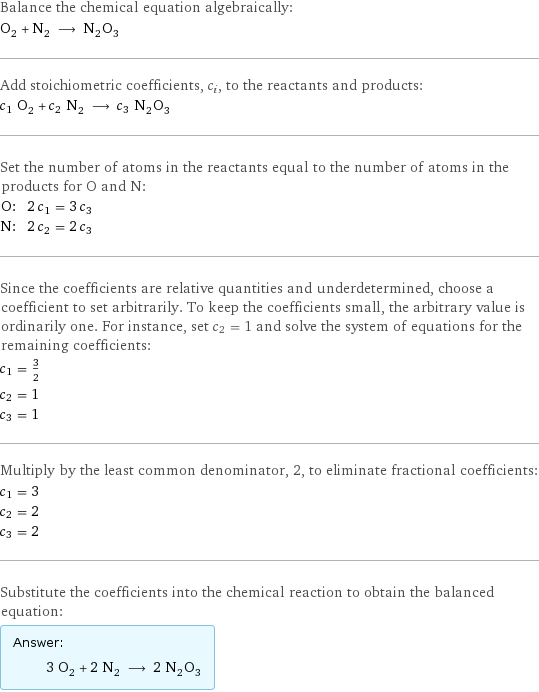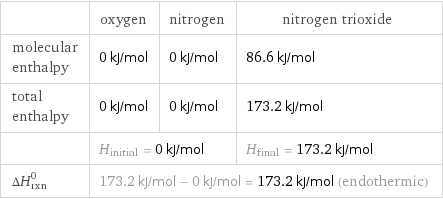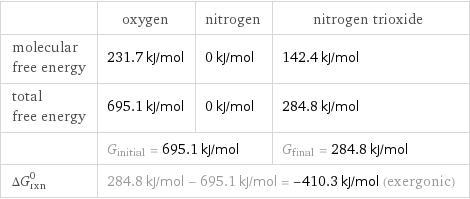Input interpretation

O_2 (oxygen) + N_2 (nitrogen) ⟶ N_2O_3 (nitrogen trioxide)
Balanced equation

Balance the chemical equation algebraically: O_2 + N_2 ⟶ N_2O_3 Add stoichiometric coefficients, c_i, to the reactants and products: c_1 O_2 + c_2 N_2 ⟶ c_3 N_2O_3 Set the number of atoms in the reactants equal to the number of atoms in the products for O and N: O: | 2 c_1 = 3 c_3 N: | 2 c_2 = 2 c_3 Since the coefficients are relative quantities and underdetermined, choose a coefficient to set arbitrarily. To keep the coefficients small, the arbitrary value is ordinarily one. For instance, set c_2 = 1 and solve the system of equations for the remaining coefficients: c_1 = 3/2 c_2 = 1 c_3 = 1 Multiply by the least common denominator, 2, to eliminate fractional coefficients: c_1 = 3 c_2 = 2 c_3 = 2 Substitute the coefficients into the chemical reaction to obtain the balanced equation: Answer: | | 3 O_2 + 2 N_2 ⟶ 2 N_2O_3
Structures

+ ⟶
Names

oxygen + nitrogen ⟶ nitrogen trioxide
Reaction thermodynamics
Enthalpy

| oxygen | nitrogen | nitrogen trioxide molecular enthalpy | 0 kJ/mol | 0 kJ/mol | 86.6 kJ/mol total enthalpy | 0 kJ/mol | 0 kJ/mol | 173.2 kJ/mol | H_initial = 0 kJ/mol | | H_final = 173.2 kJ/mol ΔH_rxn^0 | 173.2 kJ/mol - 0 kJ/mol = 173.2 kJ/mol (endothermic) | |
Gibbs free energy

| oxygen | nitrogen | nitrogen trioxide molecular free energy | 231.7 kJ/mol | 0 kJ/mol | 142.4 kJ/mol total free energy | 695.1 kJ/mol | 0 kJ/mol | 284.8 kJ/mol | G_initial = 695.1 kJ/mol | | G_final = 284.8 kJ/mol ΔG_rxn^0 | 284.8 kJ/mol - 695.1 kJ/mol = -410.3 kJ/mol (exergonic) | |
Equilibrium constant
![Construct the equilibrium constant, K, expression for: O_2 + N_2 ⟶ N_2O_3 Plan: • Balance the chemical equation. • Determine the stoichiometric numbers. • Assemble the activity expression for each chemical species. • Use the activity expressions to build the equilibrium constant expression. Write the balanced chemical equation: 3 O_2 + 2 N_2 ⟶ 2 N_2O_3 Assign stoichiometric numbers, ν_i, using the stoichiometric coefficients, c_i, from the balanced chemical equation in the following manner: ν_i = -c_i for reactants and ν_i = c_i for products: chemical species | c_i | ν_i O_2 | 3 | -3 N_2 | 2 | -2 N_2O_3 | 2 | 2 Assemble the activity expressions accounting for the state of matter and ν_i: chemical species | c_i | ν_i | activity expression O_2 | 3 | -3 | ([O2])^(-3) N_2 | 2 | -2 | ([N2])^(-2) N_2O_3 | 2 | 2 | ([N2O3])^2 The equilibrium constant symbol in the concentration basis is: K_c Mulitply the activity expressions to arrive at the K_c expression: Answer: | | K_c = ([O2])^(-3) ([N2])^(-2) ([N2O3])^2 = ([N2O3])^2/(([O2])^3 ([N2])^2)](../image_source/e6178f53c7b6a367816b6d18e71cfa0b.png)
Construct the equilibrium constant, K, expression for: O_2 + N_2 ⟶ N_2O_3 Plan: • Balance the chemical equation. • Determine the stoichiometric numbers. • Assemble the activity expression for each chemical species. • Use the activity expressions to build the equilibrium constant expression. Write the balanced chemical equation: 3 O_2 + 2 N_2 ⟶ 2 N_2O_3 Assign stoichiometric numbers, ν_i, using the stoichiometric coefficients, c_i, from the balanced chemical equation in the following manner: ν_i = -c_i for reactants and ν_i = c_i for products: chemical species | c_i | ν_i O_2 | 3 | -3 N_2 | 2 | -2 N_2O_3 | 2 | 2 Assemble the activity expressions accounting for the state of matter and ν_i: chemical species | c_i | ν_i | activity expression O_2 | 3 | -3 | ([O2])^(-3) N_2 | 2 | -2 | ([N2])^(-2) N_2O_3 | 2 | 2 | ([N2O3])^2 The equilibrium constant symbol in the concentration basis is: K_c Mulitply the activity expressions to arrive at the K_c expression: Answer: | | K_c = ([O2])^(-3) ([N2])^(-2) ([N2O3])^2 = ([N2O3])^2/(([O2])^3 ([N2])^2)
Rate of reaction
![Construct the rate of reaction expression for: O_2 + N_2 ⟶ N_2O_3 Plan: • Balance the chemical equation. • Determine the stoichiometric numbers. • Assemble the rate term for each chemical species. • Write the rate of reaction expression. Write the balanced chemical equation: 3 O_2 + 2 N_2 ⟶ 2 N_2O_3 Assign stoichiometric numbers, ν_i, using the stoichiometric coefficients, c_i, from the balanced chemical equation in the following manner: ν_i = -c_i for reactants and ν_i = c_i for products: chemical species | c_i | ν_i O_2 | 3 | -3 N_2 | 2 | -2 N_2O_3 | 2 | 2 The rate term for each chemical species, B_i, is 1/ν_i(Δ[B_i])/(Δt) where [B_i] is the amount concentration and t is time: chemical species | c_i | ν_i | rate term O_2 | 3 | -3 | -1/3 (Δ[O2])/(Δt) N_2 | 2 | -2 | -1/2 (Δ[N2])/(Δt) N_2O_3 | 2 | 2 | 1/2 (Δ[N2O3])/(Δt) (for infinitesimal rate of change, replace Δ with d) Set the rate terms equal to each other to arrive at the rate expression: Answer: | | rate = -1/3 (Δ[O2])/(Δt) = -1/2 (Δ[N2])/(Δt) = 1/2 (Δ[N2O3])/(Δt) (assuming constant volume and no accumulation of intermediates or side products)](../image_source/bc4a3ed6dea6884c98870fef4671f3c0.png)
Construct the rate of reaction expression for: O_2 + N_2 ⟶ N_2O_3 Plan: • Balance the chemical equation. • Determine the stoichiometric numbers. • Assemble the rate term for each chemical species. • Write the rate of reaction expression. Write the balanced chemical equation: 3 O_2 + 2 N_2 ⟶ 2 N_2O_3 Assign stoichiometric numbers, ν_i, using the stoichiometric coefficients, c_i, from the balanced chemical equation in the following manner: ν_i = -c_i for reactants and ν_i = c_i for products: chemical species | c_i | ν_i O_2 | 3 | -3 N_2 | 2 | -2 N_2O_3 | 2 | 2 The rate term for each chemical species, B_i, is 1/ν_i(Δ[B_i])/(Δt) where [B_i] is the amount concentration and t is time: chemical species | c_i | ν_i | rate term O_2 | 3 | -3 | -1/3 (Δ[O2])/(Δt) N_2 | 2 | -2 | -1/2 (Δ[N2])/(Δt) N_2O_3 | 2 | 2 | 1/2 (Δ[N2O3])/(Δt) (for infinitesimal rate of change, replace Δ with d) Set the rate terms equal to each other to arrive at the rate expression: Answer: | | rate = -1/3 (Δ[O2])/(Δt) = -1/2 (Δ[N2])/(Δt) = 1/2 (Δ[N2O3])/(Δt) (assuming constant volume and no accumulation of intermediates or side products)
Chemical names and formulas

| oxygen | nitrogen | nitrogen trioxide formula | O_2 | N_2 | N_2O_3 name | oxygen | nitrogen | nitrogen trioxide IUPAC name | molecular oxygen | molecular nitrogen | nitramide
Substance properties

| oxygen | nitrogen | nitrogen trioxide molar mass | 31.998 g/mol | 28.014 g/mol | 76.011 g/mol phase | gas (at STP) | gas (at STP) | gas (at STP) melting point | -218 °C | -210 °C | -111 °C boiling point | -183 °C | -195.79 °C | -27 °C density | 0.001429 g/cm^3 (at 0 °C) | 0.001251 g/cm^3 (at 0 °C) | 1.4 g/cm^3 (at 2 °C) solubility in water | | insoluble | very soluble surface tension | 0.01347 N/m | 0.0066 N/m | dynamic viscosity | 2.055×10^-5 Pa s (at 25 °C) | 1.78×10^-5 Pa s (at 25 °C) | odor | odorless | odorless |
Units
